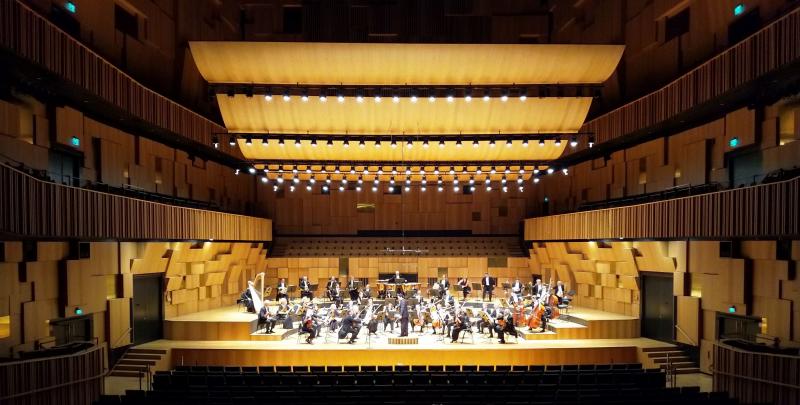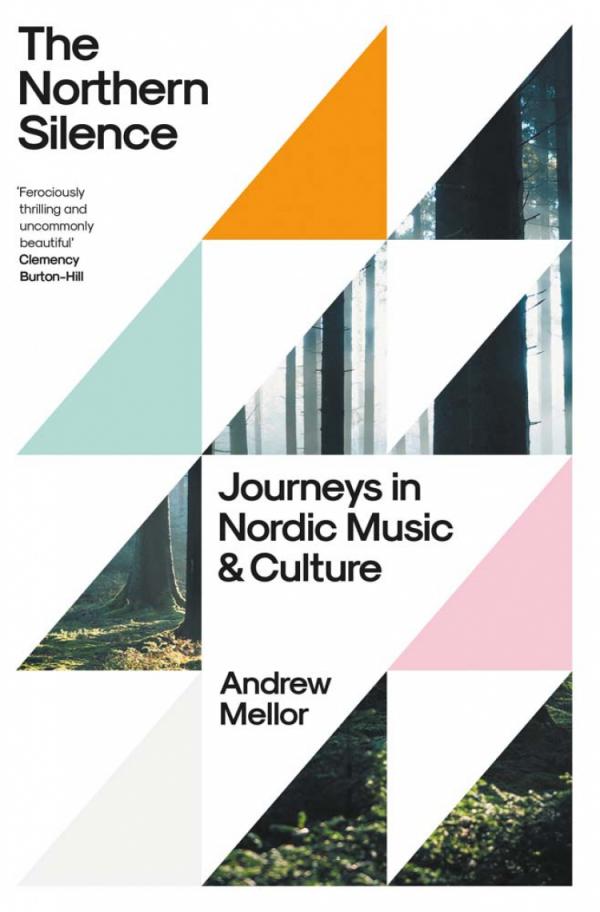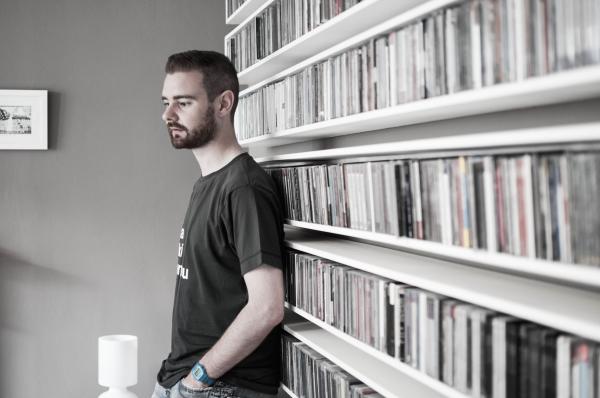Extract: The Northern Silence - Journeys in Nordic Music and Culture by Andrew Mellor | reviews, news & interviews
Extract: The Northern Silence - Journeys in Nordic Music and Culture by Andrew Mellor
Extract: The Northern Silence - Journeys in Nordic Music and Culture by Andrew Mellor
The pandemic’s failure to silence Denmark and the power of communal sound

“Silence,” Andrew Mellor contends, “is more prominent in the northernmost reaches of Europe.” Yet it is more like a texture or an apprehension of vacancy than a state of true soundlessness: sometimes “real and pure”, sometimes it “lingers despite the noise”.
Against this muted backdrop, Mellor’s new book The Northern Silence - Journeys in Nordic Music and Culture follows the circuits of musical culture across Scandinavia, Finland, Iceland and the Faroe Islands, tracing the attempts to fill the quiet, asking why “the arts, and classical music in particular, occupy a different position in national conversations here”.
Mellor has been based in Copenhagen as a music journalist for seven years. The Northern Silence is, in part, “a culmination” of his reporting during that time, guided by personal anecdote. It “makes no attempt to provide a comprehensive view of its subject”, instead gesturing towards the untameable spaces around the music, the resonant darknesses. The following extract is from the book’s postlude “Silence”.
***
Søren Kierkegaard’s best-known aphorism is that life must be lived forwards but can only be understood backwards. Anyone too young or too naïve to grasp his meaning was given a helping hand in 2020.
For a few hundred Copenhageners, a warning shot was fired on 19 February that year. We made our way to an awkwardly positioned suburb and up one of the region’s only hills, to the brick basilica that is Grundtvigs Church. Inside, a new piece by the Icelandic composer Bára Gísladóttir was to be performed. It had attracted an audience far bigger than anyone expected. Inside the church, new sections of seating were hastily being un-cordoned to accommodate the hoards.
I had come across a few of Gísladóttir’s works before. In one of them, a piece from 2015 titled Jódynur, a solo flute accompanies video footage of twelve dead horses being craned out of an Icelandic lake. The animals had trotted onto the frozen water in 2014, but temperatures were unusually high for the time of year. The ice was too thin to support their weight and the horses drowned.
This time, we were assembling for the first performance of Gísladóttir’s new work Víddir – its title another of those Icelandic words that stretches far beyond the confines of an already broad definition, ‘dimensions’. What we heard was a monolithic sound landscape lasting an hour and scored for nine flutes, electronics, percussion, organ, bass guitar and Gísladóttir’s own double bass. The one instrument the piece sought to play above all others was the one we were all huddled inside: the immense reverberating acoustic of Denmark’s most spectacular church.
The performance had felt less a warning than a prophecyFirst the herd of flutes puffed, whistled and sang into the ether, as if invoking the work itself with their ominous breeze. When the same instruments returned later it wasn’t to sing like avian creatures but to bray and caterwaul like four-legged ones, marking Víddir’s most obvious point of existential crisis. At its most overwhelming, the piece resembled a treeless Tapiola, roaring through the church’s tall nave like a gale. Its primeval rumbles and judders appeared as snapshots of a bigger process, one whose naturally recurring cycles don’t begin or end. Or didn’t, until humankind got involved.
Eventually Víddir did end. It came to rest, like Tapiola, on a tranche of distinctive light – not so much the warm glow of forest safety as the white light of general annihilation. I wasn’t the only audience member to cycle back to Copenhagen spooked. The performance had felt less a warning than a prophecy – rationally Scandinavian in its assertion that the demise of humanity was a done deal; darkly Icelandic in its willingness to examine, in sound, precisely what that might entail.
Once upon a time, nature was the bosom to which composers hurried for comfort – the portal through which a symphony could transcend into bliss, the restful idyll in which it might seek momentary repose. Nordic ‘nature music’ has long been more complicated than that – a reminder that in the north, the natural world was always the great enemy as much as the great inspiration. Sibelius’s Tapiola is freighted with nature’s awesome power. After the freewheeling energy of his Sinfonia Espansiva, Nielsen’s later symphonies sound sick and overwhelmed. The rumblings of a pandemic are never quite silenced in No. 5. One viable interpretation of No. 6 is that only the spirited will survive.
Whether or not Sibelius and Nielsen consciously anticipated it, the tables have now turned almost fully. We are fast coming to terms with a world in which nature as the comfort blanket of romantic pastoral or Mahlerian transcendence no longer exists. Nature is a cornered, injured animal prone to lashing out. We are both assailant and lifeline, guilty party and only hope.
 Plenty of Nordic music has taken up the mantle of concern. Bent Sørensen’s works suggest the purest forms of beauty are already lost to the world. Hans Abrahamsen’s retreat into the domain of all our childhoods – where it still snows, where the story turns out good but the good people don’t always survive. Others, like Gísladóttir, are looking forwards. Maja Ratkje’s 2010 sound installation Desibel positioned the world’s loudest speaker system on the side of a Norwegian mountain overlooking a salmon fjord earmarked for mining, raising the alarm courtesy of a wall of amplified trombones. Helge Iberg’s Songs from the Planet of Life (2018) presents a delicate landscape of melancholy and vitality in which we sense a creeping discomfort, the rug pulled from under nature-nostalgia by science and reason. Niels Rønsholdt’s Archive of Emotions and Experiences (2019) takes a circuitous view of mass extinction, imagining a time when the world has been purged of life as we know it – when an oracle-pianist must imagine what the previous ecosystem’s creatures known as ‘birds’ might have sounded like.
Plenty of Nordic music has taken up the mantle of concern. Bent Sørensen’s works suggest the purest forms of beauty are already lost to the world. Hans Abrahamsen’s retreat into the domain of all our childhoods – where it still snows, where the story turns out good but the good people don’t always survive. Others, like Gísladóttir, are looking forwards. Maja Ratkje’s 2010 sound installation Desibel positioned the world’s loudest speaker system on the side of a Norwegian mountain overlooking a salmon fjord earmarked for mining, raising the alarm courtesy of a wall of amplified trombones. Helge Iberg’s Songs from the Planet of Life (2018) presents a delicate landscape of melancholy and vitality in which we sense a creeping discomfort, the rug pulled from under nature-nostalgia by science and reason. Niels Rønsholdt’s Archive of Emotions and Experiences (2019) takes a circuitous view of mass extinction, imagining a time when the world has been purged of life as we know it – when an oracle-pianist must imagine what the previous ecosystem’s creatures known as ‘birds’ might have sounded like.
As birds and beasts check out of that ecosystem with ever more regularity, an early manifestation of potentially irreversible climate change looks set to be Planet Earth’s steady decrescendo. Nordic music apparently saw that coming too – from Tapiola’s structural dissolution, its muting of its own composer, to the slow but steady quieting-down of new music from the last two decades or more. Never has the silence of annihilation felt closer, scientifically or creatively. Music by Christian Winther Christensen and Johan Svensson urges us to set an ear to the ground and listen to the soil, where there might just be some last scratches, snuffles and scurries left to hear.
The global classical music community has long proved adept at speculating if and when, in a world moving culturally and economically farther and farther from the historical traditions in which it is rooted, its own music will stop. Nobody predicted that the bandwagon would judder to an abrupt halt in mid-March 2020. Whether or not the experience of the following year will prove a useful drill for climate change’s coming havoc, it did provide the world with a resonant general pause – a ‘fermata’, to use the musical term. The silence was crushing, until we got used to it. As the months dragged on, it forced the classical music community to ask the sorts of questions it had been avoiding for decades.
Exactly half a year after the first Covid-19 lockdowns halted performances in Copenhagen, I caught a train across the Øresund Bridge that links Denmark and Sweden to hear the Malmö Symphony Orchestra play Sibelius’s Symphony No. 5. There were only five spectators in the orchestra’s oak lined concert hall: four administrative staff and me. Its American chief conductor Robert Trevino looked directly into a camera as he addressed everyone else, watching the live broadcast from home. Sibelius’s symphony, he said, is a work in which overbearing trauma and overwhelming hope appear to co-exist. Asking his musicians to play a tiny snippet of the first movement, he demonstrated the harmonically elusive music’s ability to teeter between major and minor keys – walking the tightrope of fear and confidence, anxiety and freedom. (Pictured below, Andrew Mellor) The Nordic model of high taxation and high public spending served the region’s culture sector relatively well during the pandemic’s shutdowns. With ticket income always secondary, established orchestras were able to adapt. The Aalborg Symphony Orchestra quit its concert hall ‘Musikkens Hus’ and climbed aboard a bus painted to resemble the building’s distinctive architecture, ‘Musikkens Bus’. For weeks, its members trundled around north Jutland playing in the gardens and courtyards of care homes and nursing homes.
The Nordic model of high taxation and high public spending served the region’s culture sector relatively well during the pandemic’s shutdowns. With ticket income always secondary, established orchestras were able to adapt. The Aalborg Symphony Orchestra quit its concert hall ‘Musikkens Hus’ and climbed aboard a bus painted to resemble the building’s distinctive architecture, ‘Musikkens Bus’. For weeks, its members trundled around north Jutland playing in the gardens and courtyards of care homes and nursing homes.
Other Nordic orchestras were shaken from their complacency – but far from all. One that remained on stage was Trevino’s Malmö Symphony Orchestra. At the end of April, it was the last orchestra in Europe left playing at full strength, live streaming its weekly Thursday concerts from an empty hall. Trevino’s agency in Vienna started to refer to their client as ‘the last man standing’. When concert life in Denmark and Finland got going again in the autumn, those conductors who normally ply their trade in Seattle, San Francisco, London, Paris and Glasgow suddenly found themselves working at home, leading Danish and Finnish orchestras in front of Danish and Finnish audiences. The Russian music director of the Royal Danish Opera, Alexander Vedernikov, became one of many thousands of musicians for whom the actual disease proved tragically more significant than its societal repercussions. He died of Covid-19 in Moscow at the end of October 2020, aged 56, seven weeks after conducting the season opening at the Copenhagen Opera House.
Meanwhile Sweden’s governmental approach to the pandemic, unique in Europe, provided the Nordic region with its biggest rumbling of geopolitical disquiet for decades. It was felt acutely along the Øresund Bridge. Sweden imposed no formal lockdowns, closing neither schools nor businesses but eventually restricting attendance at large sports and cultural events. The country’s death rates soared far beyond those of its neighbours. For the first time in modern history, Denmark and Sweden closed ranks on one another, even imposing reciprocal travel bans. Denmark labelled Sweden irresponsible. Sweden castigated Denmark as protectionist. The usual good humour that buffers tensions between the two nations very nearly evaporated.
As 2020 groaned into 2021, it became clear that Sweden was set on playing a long game with Covid-19, however reluctant the country’s officials were to admit it. In a society prizing stability, order and the bigger picture of social welfare above all else, excess deaths from the disease among the elderly were evidently seen as a fair price to pay for protecting wider mental health and societal stability – for keeping business going, keeping education going, keeping some form of social and cultural life going. Most Swedes trusted their government to have made the right judgment, with the implication that the lockdowns enforced everywhere else in Europe would wreak economic, social and mental health havoc in the long-term. It will take years to say with any certainty whether Sweden called it right.
Music, meanwhile, proved its agency. Sweden’s orchestras and opera companies gathered and played, streaming their performances online. From the first days of the first lockdown in Denmark, the conductor Philip Faber, seated at a grand piano, led the nation in daily, televised communal singalongs. Each episode of Fællesang (‘communal song’) would begin with breathing exercises before Danes were taken through a litany of well-known numbers, the line-up underpinned by the dual icons of the country’s song tradition, the composer Carl Nielsen and the rocker Kim Larsen. The Faroese singer Teitur Lassen made an unforgettable appearance on the show, playing live on the side of a mountain on the archipelago as the low sun illuminated a tranche of the glistening North Atlantic behind him.
Migrating to Friday nights, Fællesang proved immensely popular and became a permanent fixture on the schedules. Executives at Denmark’s state broadcaster DR touted the show as the very definition of public service broadcasting – pandemic or no pandemic – in an age when hostile politicians were increasingly demanding that definition be clarified. In February 2021, the show’s TV trailer included appearances from politicians straddling the ideological divide, all endorsing the value of communal singing.
As Fællesang effectively took the place of X Factor, plenty of Danes were reminded that music can exist without the trappings of the music industry – music not as the narcissistic pursuit of individual success, but as a communal activity, a cross-generational bonding agent, a non-financial commodity that might be appreciated for its own empowering strength and beauty no matter who is delivering it. For a time, it felt as though the pandemic had done the very opposite of silencing Denmark. Once a society lets go of songs that can be sung together by every generation alive, suggested Fællesang, there isn’t much left to bind it together – an echo of the ‘original’ Fællesang meetings: expressions of democratic resistance in Nazi-occupied Denmark. Nobody was talking about genre, but the constant presence of Faber and DR’s various in-house choirs set the tone. By Christmas 2020, the Danish Government had passed a budget increasing culture funding across the board – beyond the rescue packages already agreed – and halting planned cuts to DR. Both had long since been promised, but now even the detractors seemed to get the point. Parliament waved the relevant bills through.
- This is an exclusive extract from The Northern Silence – Journeys in Nordic Music and Culture by Andrew Mellor, a TLS Book of 2022 (Yale University Press, £18.99)
- Read more book reviews on theartsdesk
Explore topics
Share this article
The future of Arts Journalism
You can stop theartsdesk.com closing!
We urgently need financing to survive. Our fundraising drive has thus far raised £49,000 but we need to reach £100,000 or we will be forced to close. Please contribute here: https://gofund.me/c3f6033d
And if you can forward this information to anyone who might assist, we’d be grateful.

Subscribe to theartsdesk.com
Thank you for continuing to read our work on theartsdesk.com. For unlimited access to every article in its entirety, including our archive of more than 15,000 pieces, we're asking for £5 per month or £40 per year. We feel it's a very good deal, and hope you do too.
To take a subscription now simply click here.
And if you're looking for that extra gift for a friend or family member, why not treat them to a theartsdesk.com gift subscription?

Add comment